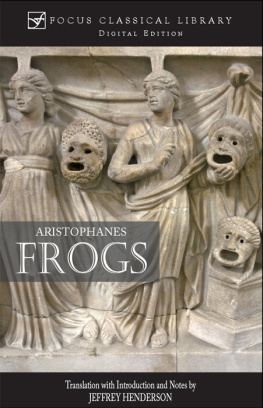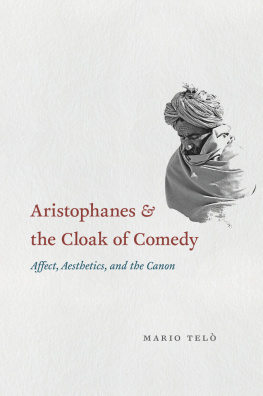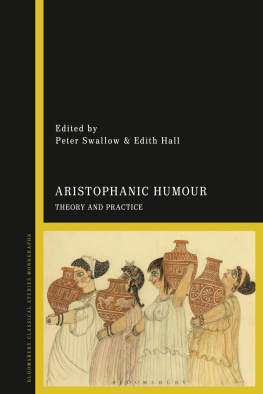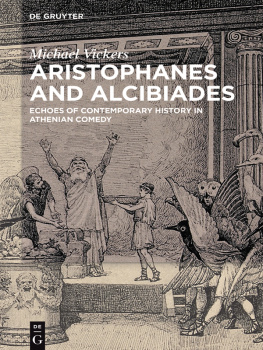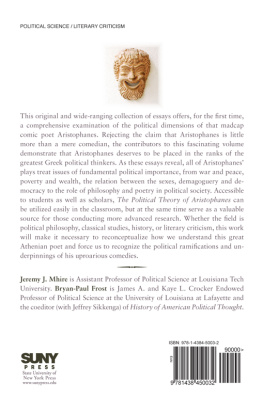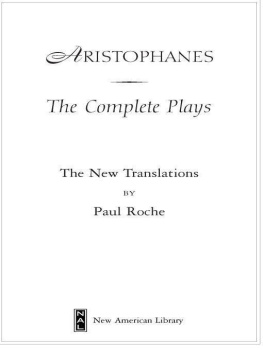Looking at Lysistrata
LOOKING AT
LYSISTRATA
Eight essays and a new
version of Aristophanes
provocative comedy
Edited by David Stuttard

Bloomsbury Academic
An imprint of Bloomsbury Publishing Plc
50 Bedford Square | 1385 Broadway |
London | New York |
WC1B 3DP | NY 10018 |
UK | USA |
www.bloomsbury.com
First published in 2010 by Bristol Classical Press,
an imprint of Bloomsbury Academic
Reprinted 2011
Introduction and editorial arrangement
David Stuttard 2010
Lysistrata, or Loose Strife
David Stuttard 2010
David Stuttard has asserted his right under the Copyright, Designs and Patents
Act, 1988, to be identified as Author of this work.
All rights reserved. No part of this publication may be reproduced or
transmitted in any form or by any means, electronic or mechanical, including
photocopying, recording, or any information storage or retrieval system,
without prior permission in writing from the publishers.
No responsibility for loss caused to any individual or organization acting
on or refraining from action as a result of the material in this publication
can be accepted by Bloomsbury or the author.
British Library Cataloguing-in-Publication Data
A catalogue record for this book is available from the British Library.
eISBN-13: 978-1-4725-1996-2
Library of Congress Cataloging-in-Publication Data
A catalog record for this book is available from the Library of Congress.
Contents
David Stuttard
J. Michael Walton
James Morwood
Edith Hall
Alan H. Sommerstein
James Robson
Alan Beale
Martin Revermann
Lorna Hardwick
David Stuttard
To EJ
Acknowledgements
My experience of staging Lysistrata goes back to 1996, when I translated and directed several scenes as part of my play Blow Your Mind, Aristophanes, performed by Actors of Dionysus at Londons Mermaid Theatre in association with Tariq Ali, Channel 4 Television and the British Film Institute. To all involved then, and to all who have subsequently performed these scenes or taken part in workshops or readings of the entire script, a big thank you for helping me to see how the play actually works. Thank you, too, to those individuals with whom I have discussed the script not least James Albrecht, Tom Davidson, Richard Dyball, Mark Katz, Sam Moorhead, Tony Ravenhall, Tamsin Shasha, Matt Smith and Ian Angus Wilkie.
The core of this volume is the essays, and unreserved thanks are due to all the contributors, both for giving so generously of their time and knowledge and for standing so firmly by the project during its long gestation period. Special thanks must go to Alan Beale, who brokered the marriage between manuscript and publisher, to Duckworth for taking it on and especially to Deborah Blake, the Editorial Director, for her excellent and unstinting work in turning it into such a handsome book. This is one time you can, perhaps, judge a book by its cover, and thanks for the striking image go to the model, Laura Williams, and photographer Dave Ashton.
Finally, my personal thanks to my partner Emily-Jane Birt-well, who, while possessing the wisdom, efficiency and organisational skills of a Lysistrata, so generously supports me in all I do.
Contributors
Alan Beale is Tutor, NE Centre for Lifelong Learning.
Edith Hall is Research Professor at Royal Holloway University of London.
Lorna Hardwick is Professor of Classical Studies and Director of the Reception of Classical Texts research project at the Open University.
James Morwood is an Emeritus Fellow of Wadham College, Oxford.
Martin Revermann is Associate Professor of Classics and Theatre Studies at the University of Toronto.
James Robson is Senior Lecturer in Classical Studies at the Open University.
Alan Sommerstein is Professor of Greek at the University of Nottingham.
David Stuttard is a freelance classicist, dramatist and writer.
J. Michael Walton is Emeritus Professor of Drama at the University of Hull.
An Introduction to Lysistrata
David Stuttard
The eight essays contained in this collection look at different aspects of Aristophanes Lysistrata, a play which has now, at the beginning of the twenty-first century, become increasingly popular and increasingly misunderstood. Part of the reason for this popularity and misunderstanding is that readers, directors and audiences are readily seduced by the plays attractive packaging (the make love not war theme), see it as surprisingly modern, and, as a result, too easily overlook the social and political context in which it was written. In this introduction, I shall briefly set Lysistrata in its historical context, as well as considering what Aristophanes aims may have been when he wrote it.
Production context
Lysistrata was first performed in Athens in early 411 BC probably at the Lenaea, one of two annual Athenian religious festivals of drama sacred to the god Dionysus. Both festivals included tragedies and satyr plays (a sub-genre of comedy with plots set in the world of mythology), as well as comedies. Comedies were not just funny; they were intensely political in nature, often using the veil of humour to make serious comments about important issues of the day. As James Morwood reminds us in his contribution to this collection, Aristophanes himself commented in his Acharnians (performed in 425 BC), Comedy too [i.e. as well as tragedy] knows about justice (line 500). Whatever the type of drama performed, in a political world completely dominated by men, the actors and choruses were all male. It is possible that the audiences were, too.
Because it was held in the month roughly corresponding to our January, the Lenaea was purely for the local community at that time of year the sea was too unpredictable to allow foreign visitors to attend. Lysistrata was therefore aimed exclusively at an Athenian (male?) audience, whose shared experience added to its sense of intimacy and immediacy.
Of course, preparations for the production had begun much earlier. The previous summer (412 BC), Aristophanes would have submitted his proposal for inclusion in the festival, part of which may have included the reading of passages from the script. For a comic writer, this must have presented its own challenges, because much of the humour of the play relied on up-to-the-minute jokes about topical events. So we must assume that it was accepted that the script was fluid and that additions might be made right up to the day of the performance. But it does mean that the overarching theme of Lysistrata that the women of Greece vote to withhold sex from their men-folk until such times as they have concluded a peace settlement had probably been decided some six months in advance of the first performance.
Historical context
The period leading up to the first performance of Lysistrata is one of the most complex in Athenian history. Events were moving rapidly and the situation was changing almost daily.
Next page

